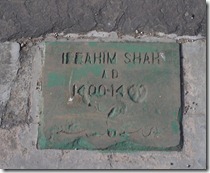The Sharqi dynasty was a medieval Shiite Muslim dynasty of North India, one of the many kingdoms that came up following the disintegration of the Delhi Sultanate.
Malik Sarwar was a prominent noble in the court of Feroz Shah Tughlaq, the Delhi sultan. During the time of Feroz's weak successors, he rose to become the "wazir" and got the title "Malik ur Sharq" meaning "Lord of the East". The pillage of Delhi by Timur in 1398 CE effectively ended the Delhi sultanate for the time being, and in the absence of any central authority, the regional vassals began to assert their independence one by one.
One of the first to assume independence was Malik Sarwar, who established himself at Jaunpur. He soon managed to extend his sway over the eastern domains of the hitherto Tughlaq sultanate, and area that extended from Agra to Dharbanga and from the borders of Assam to Bundelkhand in the south, roughly including most of present day Uttar Pradesh and Bihar states.
Following Malik Shah's death, his adopted son Mubarak Qaranfal succeeded him. He was an Abyssinian slave who once served as the water bearer of Feroz Shah Tughlaq. He struck coins in his name, consolidated the sultanate, suppressed local rebellions, established law and order and provided stability in the midst of turbulent political struggle for dominance in North India. The strong Sharqi state prevented the sultan of Bengal from becoming the dominant political force in North India.
The Sharqi sultanate reached the zenith of its glory during the reigns of Mubarak Qaranfals' two successors, Shamsuddin Ibrahim Shah and Mahmud Shah. These sultans patronized learning and culture, and with the desolation Timur wrecked upon Delhi, Jaunpur became the center of Muslim culture in North India. Many scholars, men of letters, poets, wandering mystics, and learned men, from places as far as Persia and Arabia flocked to the Sharqi court, and Jaunpur soon came to be known as "The Shiraz of the East". Kabir, the widely acclaimed poet of the era and Shah Madder, a mystic Sufi were two famous personalities who settled in Jaunpur during this time.
Ibrahim Shah established many centers of learning. This legacy still survives, and today Jaunpur is famous for its many colleges. Traces of the cultural tradition that the Sharqis established still lingers on, the legacy passed on to modern day through the later day Nawabs of Awadh.
However, the most remarkable contribution of the Sharqi sultans was in the realm of architecture. The Sharqi sultans
adorned Jaunpur with many magnificent palaces, mosques and mausoleums.
The most famous Sharqi monument that still stands is the Atala Masjid, constructed using Red Sandstone and pillars of stone. This is a landmark example of the unique Jaunpuri style of architecture that developed, incorporating many styles. The striking feature of this monument is a lofty structure shaped like a pylon with sloping slides, a style resembling that of ancient Egyptian temples. There are three tiers and the dome is almost 55 feet high, constructed by means of circular course of stone. The inscriptions in the walls give the information that Hindu artisans were employed for the construction of this mosque. Cloisters closed three sides of the mosque, and the enclosed space served as a resting spot for the weary travelers, pilgrims, and merchants. Local merchants traded out of the pillared verandah facing the street.
Other famous Sharqi mosques that still stand include Khis Mukhlis Masjid, Jhanijiri Masjid, Lal Darwaza Masjid and Masjid Jami us Sharq. The Lal Darwaza Masjid, built together with a palace for Bibi Raji, the queen of Sultan Mahmud Sharqi is a simplified reproduction of Atala Masjid, on a smaller scale. Bibi Raji established a religious school in the vicinity, open to all. This survives till date at the Lal Darwaza complex, in the name of Jamia Hussainia Madrassa. Masjid Jami-us-Sharq was the largest Sharqi masjid, built on a raised terrace without any pillars. This masjid was constructed for the convenience of a Sufi Khwaja Isa, who used to suffer much during his walk to Khalispur Masjid.

 The main aim of Edara e bani Hashim is to impart value based education, islamic educations, modern educations, technical trainings, and vocational trainings. Main Aim is to impart such education which helps the students to get supremacy in education and to learn some basic skills which are essential even after they leave institution. faciality of computer education is also there which is an additional knowledge by making leaving a multi sensory activities. Other aim is to help the poor and needy person by differet means.
The main aim of Edara e bani Hashim is to impart value based education, islamic educations, modern educations, technical trainings, and vocational trainings. Main Aim is to impart such education which helps the students to get supremacy in education and to learn some basic skills which are essential even after they leave institution. faciality of computer education is also there which is an additional knowledge by making leaving a multi sensory activities. Other aim is to help the poor and needy person by differet means. 


No comments:
Post a Comment